Inside W Sydney hotel at Darling Harbour
After extended delays, W Sydney is opening with an ambitious, cinematic and wildly irreverent look. We got exclusive access, now you can see the pictures.
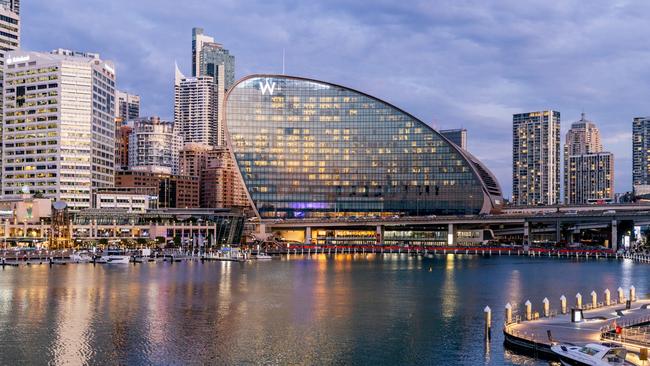
Wedged between twin motorways whizzing by Darling Harbour, The Ribbon is an enigma in the Sydney cityscape. Its undulating glass façade resembles an architectural Rorschach test, inviting observers to decipher its meaning. Do you see a playful wavelike form? A crystalline spaceship from a celestial dimension? Or a colossal snail sandwiched by wafers? The mollusc metaphor is fitting considering the unhurried pace at which the building was constructed. Developer Greaton embarked on the $1 billion project in 2016. Two years later, Marriott International announced it would house W Sydney by 2020. Stalled by the collapse of two builders and stymied by the pandemic, it seemed the hotel would never unfurl its blue-ribbon design.
The good news is the hotel’s protracted gestation has been worth it. Opening this month, W Sydney has a boffo look that is vividly hued, richly iconoclastic, and unashamedly joyous. “There are only a few places in the world where you would attempt to build this,” said Stephen Crawley, appraising the eclectic building by Hassell architects on a recent morning. Crawley is a co-founder of Bowler James Brindley (BJB), the London-based studio entrusted with crafting the hotel’s interiors. “The inside has to deliver to the same magnitude as the outside,” he added. Intense sunlight permeated the translucent design marvel, accenting its trippy, funhouse ambience. “The last thing you want is to be underwhelmed.”
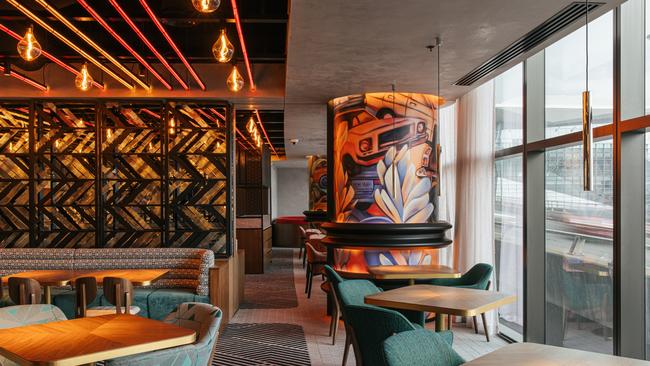
Not a chance. As I toured the space with Crawley and co-founder Lucy Southall – Ian Bayliss, the third principal, was in London – I was wowed with a capital W. In the United Kingdom, BJB is known for its lavish abodes that combine the swagger of Mick Jagger with the wit of Eartha Kitt. Marriott has tapped the trio as collaborators on a number of other projects, including the recently unveiled W Budapest, a bijou lodging within a former neo-Renaissance palace. Immersive storytelling is clearly their forte. Perched atop the Imax theatre, W Sydney has a bold, cinematic presence whose elevator pitch might be “Blade Runner meets The Great Gatsby”. In response to the building’s elliptical shape and monumental size, the designers proposed a series of poppy tableaux for its public spaces to whet the appetites of visitors and guests alike.
Cut first to the lobby, with its imposing concrete pillars, outsized red-petalled W, and eye-catching staircase traced in linear blue lights. Adjacent to this portal is a cosy seating area, a bank of elevators, and a wall composed of hexagonal copper cut-outs that suggest a honeycomb structure – what follows is a beehive of activity. Ascending to the next level reveals the hotel reception, which gives way to the Living Room, a rakish lounge with cobalt-blue furnishings that evoke a bowerbird’s plumage. Up another flight leads to the spa with its whimsical relaxation pods and manicure stations, enormous circular forms swathed in clementine-coloured metal and leather, and graphic geometric windows rendered by artist Bradley Eastman. In an era when luxury hotel and restaurant interiors so often serve up oatmeal tones, W Sydney embraces brassy, performative glamour instead.
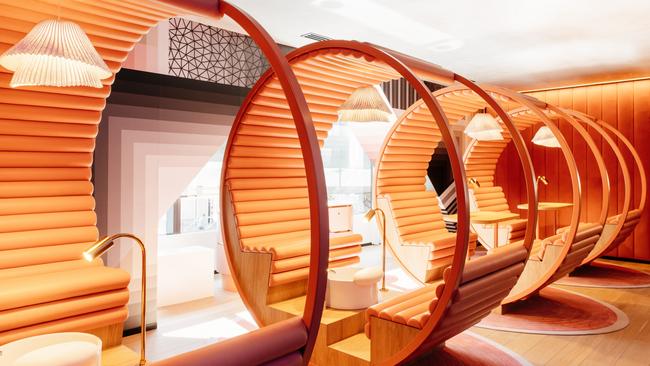
On level three, the plot thickens – and quickens. Btwn, the hotel’s sprawling restaurant, occupies an entire floor and offers unimpeded views of an elevated carriageway. Initially, the designers were tempted to paper over the traffic skirting the western edge of the city. “We tried to ignore it,” said Southall, with opaque curtains and hushed fittings. Ultimately, they decided to engage with the vehicular ballet outside. Red track ceiling lighting, chevron patterns that recall road signs, and columns decorated with aerosol art by Sophi Odling now infuse Btwn with a high-octane energy, bringing to mind Mad Max – if George Miller’s antihero ever had a hankering for orange vino and kingfish crudo. “There’s a juggernaut going past, and you have to embrace it,” said Crawley.
What prevents the design from being an aesthetic collision is BJB’s masterful control of the disparate elements. The restaurant proper on the far left is a smart medley of pigments, patterns, and wall treatments, including one that mimics the perforated leather lining of a fancy sedan. I could imagine local power brokers and jet-setting travellers breaking bread here, enjoying lamb shoulder and poached cod by chef Chris Dodd, formerly of Aria. Btwn features four lozenge-shaped stations, one of which is dedicated to 2am by Singaporean dessert virtuoso Janice Wong. Wong’s aerated, torched, and parfait-ed confections, served late and paired with boozy accompaniments, might well challenge the dietary absolutism of intermittent fasters.

The tantalising tale keeps unfolding on level five, a convergence of sinuous walls, oversized pendants, and carpet woven with coruscating fireworks for the hotel’s ballroom. The maritime motif, revealed on its sun-drenched balcony, is echoed in the guest rooms above. Accessed via dimly-lit corridors, these luminous chambers are kitted out with nautical shades, mirrored furnishings, and magenta accents – a waratah wallpaper by artist Alesandro Ljubicic in the walk-in wardrobe. The rooms have an uncommon fluidity, with hidden illumination, woven headboards, and curvaceous beds and chaises. “Builders hate organic shapes, but we were never told to rein it in,” said Crawley.
With an inventory of 588 rooms, including 162 long-term studios and specialty suites equipped with kitchens, the Sydney venture will be the largest W in the world. The hotel is a triumphant return to the Emerald City for the marque, which first materialised in 2000 at Woolloomooloo’s Finger Wharf; that property was rebranded in 2007. In 2018, W Brisbane marked the brand’s local re-entry with 312 rooms, edgy tints, and kitsch touches like jewelled cane toads. The 294-room W Melbourne, which arrived in 2021, has a moody and maximalist style inspired by the city’s laneway culture.
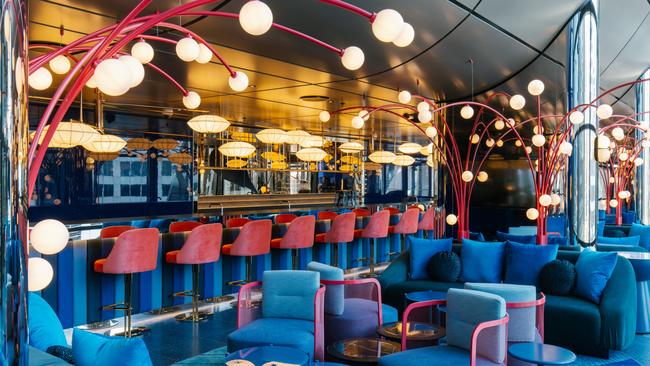
To distinguish from W’s predecessors and upscale competitors like Crown Sydney, Capella Sydney, and the forthcoming Waldorf Astoria, Marriott sought BJB’s worldly perspective. “W is a very experiential brand,” said Southall. “They want a story, a narrative. For Sydney, we dialled it up.” The designers were encouraged to dip into a Vegemite jar of Australian symbols – there are nods to emus, sharks, and larrikins, plus the bowerbirds and waratahs – yet the execution is tasteful, playful, and polished. Since its inception in the late ’90s, spearheaded by visionary architect David Rockwell in New York, W has revelled in its theatrical side. “W is about colour as material,” added Southall. “Marble is not always the answer.”
The chromatic approach culminates in the uppermost reaches of the hotel. Nestled on level 29 is a cocktail den, supper club, and a free-flowing pool deck with cerulean vistas in every direction. “This is a superyacht in the sky,” said Crawley, albeit one built by Aristotle Onassis, refurbed by Austin Powers, and animated with groovy shades of turquoise, scarlet and orange. While the pool remains an exclusive oasis for hotel guests, the cocktail bar serving Basque-inflected tapas is open to all. Gazing out from this vantage point, one feels as though they are aboard a glass galleon, adrift on the glittering waters of Darling Harbour. It’s a transformative shift for the precinct, which has seen its popularity ebb and flow.
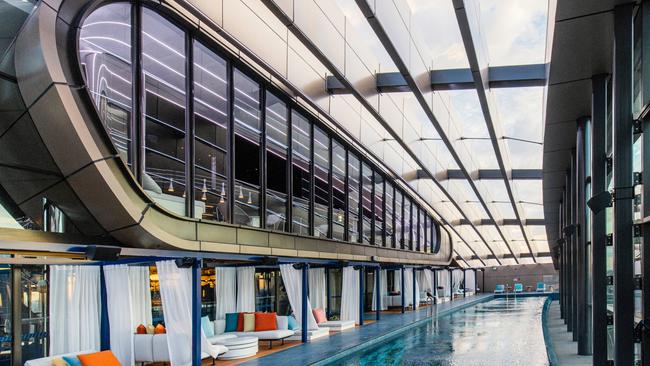
The bar’s upper tier on level 30 adopts a more subdued palette, befitting its selection of rarefied Champagnes, including Krug, Ruinart, and Dom Pérignon, by the glass. The views are equally effervescent, a chance to admire the mosaic sea creatures ornamenting the infinity pool and the billowing cabanas below. “In the evening we will close the pool and hotel guests can move to our indoor one on the 22nd floor,” Craig Seaward, the hotel’s affable general manager, told me. Seaward is planning gastronomic pop-ups, DJ appearances and a line-up of activations to ensure W Sydney is abuzz this summer and beyond. “We are trying to create the third icon behind the Opera House and the Bridge,” he added.
A few days later, I reconnected with the London team on a video call. “The Ribbon is certainly a spectacular building,” said Bayliss, who joined us. “But when a building is really strong, you have to impose your will on it.” In lieu of insipid art, BJB sought to create a sculptural statement through their audacious use of colour. “We wanted to do something different,” said Crawley. In Sydney, Crawley observed that many high-end venues shared a soulless uniformity. “It’s all white marble, a bit of timber here, a lovely bit of velvet sofa there. It’s like a luxury handbag – you can place it anywhere.” If papa needs a brand new bag, W Sydney is it.

W Sydney will open 12 October. Rates start at $599 for a king room with city views. wsydney.com

To join the conversation, please log in. Don't have an account? Register
Join the conversation, you are commenting as Logout